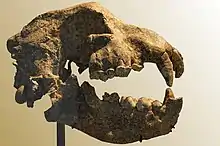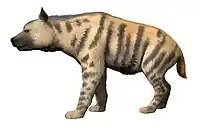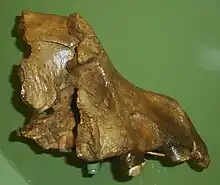Pachycrocuta
Pachycrocuta is an extinct genus of prehistoric hyenas. The largest and most well-researched species is Pachycrocuta brevirostris, colloquially known as the giant short-faced hyena as it stood about 90–100 cm (35–39 in) at the shoulder[2] and it is estimated to have averaged 110 kg (240 lb) in weight,[3] approaching the size of a lioness, making it the largest known hyena. Pachycrocuta first appeared during the late Miocene (Messinian, 7.2 to 5.3 million years ago[4]). By 800,000 years ago, it became locally extinct in Europe, with it surviving in East Asia until at least 500,000 years ago, and possibly later elsewhere in Asia.[5]
| Pachycrocuta Temporal range: | |
|---|---|
 | |
| Cast of the holotype skull at the Musée Crozatier | |
| Scientific classification | |
| Domain: | Eukaryota |
| Kingdom: | Animalia |
| Phylum: | Chordata |
| Class: | Mammalia |
| Order: | Carnivora |
| Suborder: | Feliformia |
| Family: | Hyaenidae |
| Genus: | †Pachycrocuta Kretzoi 1938 |
| Species: | †P. brevirostris |
| Binomial name | |
| †Pachycrocuta brevirostris (Gervais, 1850) | |
| Subspecies[1] | |
| |
Taxonomy
The first identified fossil of the short-faced hyena was discovered in Le Puy, Auvergne, France, in 1845 by French paleontologist Auguste Aymard. In 1850, French paleontologist Paul Gervais made it the holotype specimen of a new species, Hyaena brevirostris. But, in 1893, while writing a much more detailed description, French paleontologist Marcellin Boule mistakingly listed Aymard as the species authority instead of Gervais, citing volume 12 of Aymard's Annales de la Société d'Agriculture, Sciences, Arts et Commerce du Puy which does not mention the species at all. Boule further gave the annal's publication date as 1846 instead of the correct 1848. The fallacious authority Aymard, 1846, was reprinted for over a century until Spanish paleontologist David M. Alba and colleagues on behalf of the International Code of Zoological Nomenclature convincingly falsified it in 2013.[6]
The short-faced hyena was usually relegated to the genus Hyaena alongside the modern striped hyena and brown hyena. In 1938, Hungarian paleontologist Miklós Kretzoi suggested erecting a new genus for it, Pachycrocuta, but this only became popular after Giovanni Ficcarelli and Danilo Torres' review of hyena classification in 1970. They, like many priors, placed Pachycrocuta as ancestral to Crocuta (the modern spotted hyena).[1]

Dozens more short-faced hyena remains have been found across Europe. In 1828, Jean-Baptiste Croizet and Antoine Claude Gabriel Jobert created the species "H. perrieri" for a specimen from Montagne de Perrier, France. In 1889, German paleontologist Karl Weithofer described "H. robusta" based on a specimen from Olivola, Tuscany, Italy, but Boule quickly synonymized it with "H." brevirostris in 1893. In 1890, French paleontologist Charles Depéret erected "H. pyrenaica" based on a specimen from Roussillon. Short-faced hyenas were also being discovered in East Asia. In 1870, English naturalist Richard Owen described a Chinese specimen as "H." sinensis. In 1908, French paleoanthropologist Eugène Dubois described a Javan one as "H. bathygnatha". In 1934, Chinese paleoanthropologist Pei Wenzhong described another Chinese one, "H." licenti, from the Nihewan Basin. In 1954, mammalogist R. F. Ewer described "P." bellax" from Kromdraai, South Africa. In 1956, Finnish paleontologist Björn Kurtén identified the subspecies "H. b. neglecta" from Jammu, India (he also chose to classify several other short-faced hyenas as subspecies of brevirostris.) In 1970 Ficcarelli and Torres relegated these to Pachycrocuta, though "P. perrieri" is sometimes split off into a different genus, Pliocrocuta, erected by Kretzoi in 1938.[1][7] In 2001, P. brevirostris was identified in Gladysvale Cave, South Africa.[8]
Usually, no more than one or two Asian short-faced hyenas were considered distinct from the European P. brevirostris. The two species convention was especially popular among Chinese scientists. As the 20th century progressed, they were often classified as regional subspecies of P. brevirostris, with P. b. brevirostris endemic to Europe, and P. b. licenti and P. b. sinensis to China.[1] In 2021, Chinese paleontologist Liu Jinyi and colleagues reported the largest ever short-faced hyena skull from Jinniushan, Northeast China, belonging to P. b. brevirostris, demonstrating the subspecies is not endemic to Europe. They suggested P. b. licenti (Middle Villafranchian) evolved into P. b. brevirostris (Late Villafranchian), which evolved into P. b. sinensis (Galerian). Relict populations of P. b. licenti seem to have persisted for some time in southern China while P. b. brevirostris had replaced most other populations. Liu and colleagues were unsure how other supposed subspecies fit into this paradigm.[1]
Evolution
The oldest fossils usually considered to belong to the genus are known from the Pliocene of East Africa,[5] the species P. bellax, known from the Early Pleistocene of South Africa, falls within the morphological variation of P. brevirostris, though its geographical separation from the that species renders its validity equivocal.[5] has been proposed that P. brevirostris ultimately evolved in Asia from Pliocrocuta perrieri, which is only distinguishable from P. brevirostris by the presence of a metaconid on the first molar. The earliest fossils of P. brevirostris in Europe date to around 1.8-2 million years ago, with the earliest fossils in East Asia probably being slightly older. P. brevirostris became extinct in Europe around 800,000 years ago, following the arrival of the spotted hyena (Crocuta crocuta), which is suggested to have outcompeted Pachycrocuta. The latest remains from East Asia are from the Zhoukoudian site, dating to around 500,000 years ago, and the species may have persisted later elsewhere in Asia.[5]

Behaviour
A cache of very comprehensive bone material was unearthed at the famous Zhoukoudian cave site in Northern China, which probably represents the remains of animals using these caves as lairs for many millennia.[2] At the western end of their former range, at Venta Micena in southeastern Spain, a huge assemblage of Pleistocene fossils also represents a den.[9] Similar to the modern day striped hyena, Pachycrocuta is often suggested to have been a kleptoparasitic scavenger of the kills of other predators, such as sabertooth cats.[10] Pachycrocuta scavenged for food, probably preferentially so, because it was a heavyset animal not built for chasing prey over long distances. In this respect it would have differed from the spotted hyena of today, which is a more nimble animal that, contrary to its image as a scavenger, usually kills its own food, but often gets displaced by lions. Apparently it was ecologically close enough to its smaller (but still large) relative Pliocrocuta perrieri that they are never found as contemporary fossils in the same region. Research by anthropologists Noel Boaz and Russell Ciochon on remains of Homo erectus unearthed alongside Pachycrocuta at the Zhoukoudian site attributed scoring and puncture patterns observed on hominin long bones and skulls—originally thought to be signs of cannibalism—to predation by Pachycrocuta.[11] However, other authors have argued that while P. brevirostris likely engaged in kleptoparasitism, it was likely equally capable of hunting medium-large sized prey in packs, similar to living spotted hyenas.[5]
See also
- Cave hyena (Crocuta crocuta spelaea)
Notes
- Liu, J.; Liu, J.; Zhang, H.; et al. (2021). "The giant short-faced hyena Pachycrocuta brevirostris (Mammalia, Carnivora, Hyaenidae) from Northeast Asia: A reinterpretation of subspecies differentiation and intercontinental dispersal". Quaternary International. 577: 29–51. doi:10.1016/j.quaint.2020.12.031. S2CID 234125458.
- Turner, Alan; Antón, Mauricio (1996). "The giant hyaena Pachycrocuta brevirostris (Mammalia, Carnivora, Hyaenidae)". Geobios. 29 (#4): 455–468. doi:10.1016/S0016-6995(96)80005-2.
- Palmqvist, P.; Martinez-Navarro, B.; Pérez-Claros, J. A.; Torregrosa, V.; Figueiridio, B.; Jiménez-Arenas, J. M.; Patrocinio Espigares, M.; Ros-Montoya, Sergio; De Renzi, M. (2011). "The giant hyena Pachycrocuta brevirostris: Modelling the bone-cracking behavior of an extinct carnivore". Quaternary International. 243 (#1): 61. doi:10.1016/j.quaint.2010.12.035.
- A. Hill, G. Curtis, and R. Drake. 1986. Sedimentary stratigraphy of the Tugen Hills, Baringo, Kenya. Geological Society of America Special Publication 25:285-295
- Iannucci, Alessio; Mecozzi, Beniamino; Sardella, Raffaele; Iurino, Dawid Adam (15 November 2021). "The extinction of the giant hyena Pachycrocuta brevirostris and a reappraisal of the Epivillafranchian and Galerian Hyaenidae in Europe: Faunal turnover during the Early–Middle Pleistocene Transition". Quaternary Science Reviews. 272: 107240. doi:10.1016/j.quascirev.2021.107240. S2CID 239548772. Retrieved 25 August 2022.
- Alba, D. M.; Vinuesa, V.; Madurell-Malapeira, J. (2013). "On the Original Author and Year of Description of the Extinct Hyaenid Pachycrocuta brevirostris". Acta Palaeontologica Polonica. 60 (3): 573–576. doi:10.4202/app.00017.2013. S2CID 58934786.
- Julia, R.; de Villalta, J. F. (1984). "El yacimiento de vertebrados del Pleistoceno inferior de Crespia (Girona, NE de la Península Ibérica)" (PDF). Acta Geológico Hispánica (2): 129–138.
- Mutter, R. J.; Berger, L. R.; Schmid, P. (2001). "New evidence of the Giant Hyaena, Pachycrocuta brevirostris (Carnivora, Hyaenidae), from the Gladysvale Cave deposit (Plio-pleistocene, John Nash Nature Reserve, Gauteng, South Africa)". Palaeontologica Africana. 37: 103–113. hdl:10539/16372.
- Walker, Matt (4 March 2011). "Prehistoric giant hyena's bone-cracking habit". BBC Earth News. Retrieved 4 March 2011.
- Walker, Matt (2011-03-04). "Prehistoric giant hyena's bone-cracking habit". BBC Earth News. Retrieved 2018-06-28.
- Boaz, Noel T.; et al. (2001). "The Scavenging of 'Peking Man'". Natural History (#110): 46–52.
References
- Raoul J. Mutter, Lee R. Berger, Peter Schmid. 2001. New evidence of the giant hyena, Pachycrocuta brevirostris (Carnivora, Hyaenidaae), from the Gladyslave cave deposit (Plio-Pleistocene, John Nash Nature Reserve, Gauteng, South Africa). Palaeont. afr., 37, 103-113